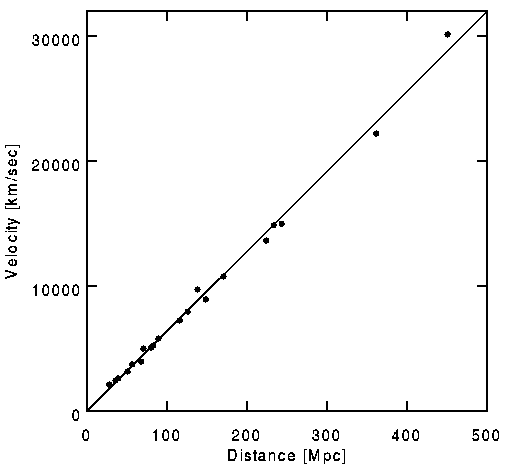
| MadSci Network: Astronomy |
Dear Martin,
That's a very good question! I'm going to give a little background information here, for other folks who may read this answer. The "Hubble flow" is used to refer to the observation that galaxies which are further away from us have larger redshifts, that is, their spectral lines are shifted further towards the red end of the spectrum. This behavior of spectra is called a Doppler shift -- it's the same phenomenon that causes the apparent pitch of a race car engine to change as it's moving toward or away from you.
It's kind of a question of terminology whether you say that distant
galaxies are actually moving away from us, or are being "carried with the
expanding universe", but the effect is the same -- in their spectra, it
looks like the galaxies have a large velocity away from us, and the
further away they are, the faster they are receding. In equation form, v=
H x D, where v is velocity, D is distance, and H is a constant called
(you
guessed it) "the Hubble constant". Here's an example "Hubble diagram",
from Ned
Wright's comology tutorial (data from Riess, Press & Kirshner):

Usually when we talk about plotting points on a Hubble diagram, we emphasize how difficult it is to make the distance measurements. Galaxies don't come with labels that say exactly how far away they are, so lots of clever tricks based on things like exploding and variable stars have to be used. See this answer for some information about how supernovae are used to measure distances, for example.
But you are correct to point out that the apparent velocity away from us (we call this the radial velocity because it's along the line directly between us and the galaxy) can actually have 2 components: the "Hubble velocity" (the part due to the expansion of the universe) and the peculiar velocity (the part due to the motion of an individual galaxy with respect to the expansion). There is no way to tell the difference between these 2 types of motion from a galaxy's spectra, so we have to use some other method to figure out the peculiar velocity. Then the peculiar velocity can be removed from the measured radial vleocity before plotting it on a diagram like the one above.
OK, so how do we measure peculiar velocities? This is a tough problem. For galaxies which live in big clusters of galaxies, a lot of their pecuilar velocity will be due to motion about the center of the cluster. This will tend to average out over the whole cluster -- some galaxies will be moving towards us within the cluster, and some away -- so we can measure the average radial velocity of the cluster galaxies and use that as a good estimate for the Hubble velocity of all the galaxies in the cluster. There are also more complicated methods which involve measuring the velocities of a lot of galaxies and trying to figure out what the gravitational effects of all the other galaxies should do to the peculiar velocity of each. This involves solving a lot of equations simultaneously and as you can imagine it gets pretty complicated!
A very good article on this topic is The Density and Pecuilar Velocity Fields of Nearby Galaxies" by Strauss and Willick. It's pretty technical but covers everything in a lot of detail, including a much more detailed description of the methods of measuring the Hubble flow. The site this article is on, NED, has a lot of other information about galaxies and cosmology as well -- check it out!
Pauline
Try the links in the MadSci Library for more information on Astronomy.